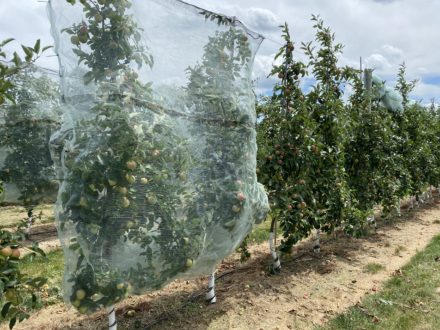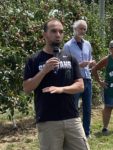

Oct 10, 2022Netting on fruit trees curbs thinning needs
Results from six years of evaluation by tree fruit researchers have demonstrated that insect exclusion netting can be used to reduce or eliminate apple thinning.
Preliminary findings of the work were presented July 28 as Michigan Pomesters presented its 11th annual Ridgefest field day, touring research trials at Michigan State University’s (MSU) Clarksville Research Center.
MSU tree fruit physiologist Todd Einhorn outlined a series of projects that explore thinning and crop load management issues.
“We’ve been doing a lot of work on netting and some of the really interesting biology that we’re seeing in terms of tree response to netting,” Einhorn said. “(This includes) the use of insect exclusion anti-hail nets to reduce fruit set and ultimately mitigate your thinning needs.”
Researcher Mokhles Elsysy has worked with Einhorn to evaluate the feasibility of using nets to manage crop load by excluding pollinators.


“Enclosing canopies with insect exclusion netting will produce a range of crop loads, depending on the percentage of open bloom accessible to pollinators prior to the time of canopy enclosure, that results in optimum crop loads that do not require thinning,” Elsysy told those attending the field day.
“Fruit from early net enclosure timings (pink and less than 20% of king bloom) have markedly fewer seeds than later timings or control but similar fruit weight and symmetry,” Elsysy said. “Fruit set responses, however, vary widely among cultivars. Fuji and Gala can be netted at less than 40% king bloom, while Honeycrisp requires a greater percentage of open king bloom (at least 75%) prior to netting).
Using protective nets during early bloom can prevent pollinators from continuing their work, resulting in reduced fruit set that might eliminate the need for hand or chemical thinning for multiple varieties.
Elsysy said the researchers also are evaluating the relationship between seed content and fruit quality. It has been accepted for decades that pollination, which leads to seed set, improves the quality of the fruit.
So far in the MSU trial, there has not been a significant relationship between the number of seeds and fruit weight and shape, spurring interest in further review. Initial trial results didn’t show a strong relationship between seed number and fruit weight and shape, however, implying the relationship is not as strong as the scientific literature suggests, Elsysy said.
The project started in 2017 in cooperation with Washington State University. Evaluators netted two different cultivars, Gala in Michigan and Honeycrisp in Washington.
“The first objective is to reduce the need to apply chemical thinner,” Elsysy said. “We need to set crop load. It will apply for everyone, but especially organic producers. With the use of nets on the trees, we think we can reduce crop load and reduce the need for chemical thinners.”
Surprise for researchers
“We did this work in 2017 and 2018,” Elsysy said. “The results were completely astonishing. We put on the nets so no bees would come to the trees at all. Still, it produced a commercial crop load. The process between the netted and non-netted, in general, was very clear. When you put the nets at different stages of open flower or bloom, you will be able to control crop load.
“The later you put on the nets, the less crop load you will have,” he said. “There are many interesting aspects we found as we worked through this project. Why do we have fruit when we net the tree without any pollination or pollen transfer happening, because there’s no bees?”
Elsysy said researchers opened the fruit thinking all of it would be seedless fruit.
“With no pollen transfer, you should get no seeds. But, when we cut the fruit, these fruit were full of seeds,” he said. “They are not the same amount as the non-netted trees, but. In Gala, you have several seeds in the fruit, and at a little bigger stage you can have three or four seeds per fruit. How did these seeds develop?”
The project was extended to study the seeds from the biggest stage of netted fruit vs. the unnetted fruit.
“We planted the seeds and grew them into plants. We needed to look at the leaves to examine the geo-timing of these seeds to be able to predict and understand what the absence of pollen does to these fruit. We are running this analysis now and are waiting to see how a transfer will happen under the nets.”
Also evaluated was the number of seeds in the fruit and whether it changed the fruit weight and shape.
“Usually, the higher the seed number, the bigger the fruit, but I cut many Honeycrisp fruit with 10 seeds in them and the fruit is still 80 or 90 grams,” he said.
“In the last two years, we’ve cut up approximately 20,000 fruit. After we looked at the effect of seed number on shape and fruit weight, we came to the idea that all trees have the capability of producing seedless fruit. That’s been written in textbooks for a hundred years.”
To see how seedless fruit drop, an evaluation was made of the trees at fruit set, analyzing what’s leading to the minimal-seeded fruits’ proliferation.
“The project started as a way to mitigate the use of chemical thinners, but now it’s opening new gates to look at how seeds impact weight and shape, and how we can understand better about how pollen transfer happens without bees,” Elsysy said.
“It’s written in the literature that the higher the seed number the lower return bloom you will have,” Elsysy said. “I submitted a 42-page paper that challenges the impact of seed number on return bloom. We don’t see much difference in return of bloom.”
Researchers will attempt to determine how “wind pollination” might impacted the fruit, which in the trial is protected by commercial nets that don’t allow bees to enter.
“If we could prove that wind pollination is taking effect, that would really help us think about the design of our orchard,” he said. “It will help us to meet the challenge of non-pollination years.”
—Gary Pullano, senior FGN correspondent
Top photo: Dropping protective nets during early bloom can prevent pollinators from continuing their work, resulting in reduced fruit set that might eliminate the need for hand or chemical thinning for multiple varieties. PHOTOS: Gary Pullano
Bottom photo: Michigan State University researcher Mokhles Elsysy, left, and MSU tree fruit physiologist Todd Einhorn discuss the utility of using nets to manage crop load by excluding pollinators.














